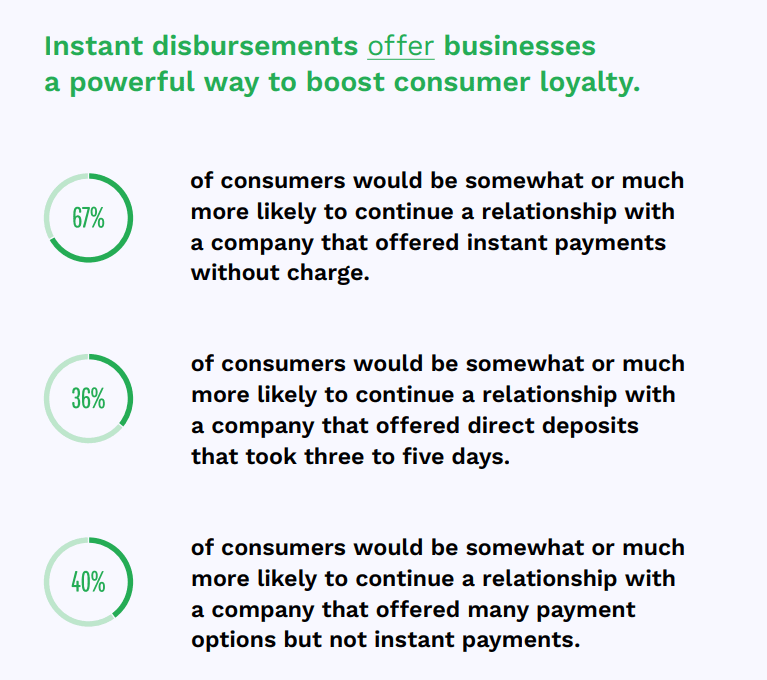From 5G cell phones to high-speed internet, from nano-second stock trading to instant Venmo payments to friends and more. The “want-it-now” culture is in the driver’s seat and has no intention of hitting the brakes anytime soon, be that in our personal or professional lives.
Take payday, for example. Where a paper check delivered in-hand every Friday was the bedrock of the American economy for generations. Today, payroll that is not deposited electronically is a rarity, and studies show that, too, could soon be the pokey exception to the faster and emerging new norm.

According to the November edition of the “Money Mobility Tracker®: The Rise Of Digital And Early Access Compensation,” the data clearly shows that demand for payday on the fly is on the rise.
Nearly 7 in 10 workers said they would be more likely to stick with an employer that offered instant disbursements for free.
What’s interesting is that that number drops in half when the speed goes away or the cost goes up.
Advertisement: Scroll to Continue
While this practice has been the norm for Uber drivers for years, the study found that the instant payday feature is coming to more companies and countries than ever, especially in lower-wage, tighter household budget situations, or with staff who earn tips. Faster payday has a huge fanbase.
Faster Fast Food
Who better to turn to than fast food mavens of the quick-serve restaurant (QSR) industry for examples of getting consumers their fix faster than ever?
Having now made permanent most of the pandemic-era ordering and delivery conveniences that were born out of necessity, the current phase is one of refining what’s now in place. It’s a task that’s aimed at a moving target of sorts as consumer experiences and expectations continue to rise.

In an interview with PYMNTS for the just-published “Restaurant Digitization Tracker®: What Customers Demand From Their QSR Ordering Experiences,” BurgerFi CTO Karl Goodhew addressed these evolving customer service demands that dominate the state of play and insistent today, compared to the COVID-panic that existed 2 or 3 years ago.
“Over time, expectations became elevated: Food should still be hot, drive times should be reasonable, and from an operations perspective, it’s essential to ensure that speed of service is right on point,” Goodhew said.
Predictably, delivery and drive-thru continue to be QSR growth areas for most players, though PYMNTS reported this week that category leader McDonald’s is seeing a retrenchment at its drive-thrus whereas some coffee-related players like Starbucks and Dutch Bros. continue to see growth.
While speed and convenience are priorities at the drive-thru window, the consumer concern does not appear to be about speed as much as it is about quality and experience. It’s one thing to be fast, but it’s another thing to be good.
Get Me Out of Here
Rounding out this week’s high-speed trilogy is the seemingly unquenchable thirst for a faster checkout experience. As much as consumers love their “retail therapy,” once a selection has been made they simply cannot be on their ways fast enough.
But in the case of eCommerce, this critical last step of the journey was also shown to be one of the biggest determinants of the next visit, as 90% of consumers told PYMNTS that a bad checkout experience is a make-or-break factor in their decision to return.
While the checkout experience, for our research purposes, consists of more than a dozen different components ranging from easy sign-in to coupons to real-time inventory data and more, the actual payment itself has also got to be swift, secure and generally seamless to trigger consumer ire.
To that point, the new report, “How We Pay Digitally: Stored Credentials Edition,” from PYMNTS and Amazon Web Services, delves into the delicate but critical decisioning that goes into storing your payment info with a particular retailer or site or choosing to re-enter the next time you visit.
 As any one-swipe Amazon buyer can attest, stopping to tap in a 16-digit code and four or five other morsels of payment information is anathema to the seamless commerce that has vaulted the world’s most successful eTailer to where it is today.
As any one-swipe Amazon buyer can attest, stopping to tap in a 16-digit code and four or five other morsels of payment information is anathema to the seamless commerce that has vaulted the world’s most successful eTailer to where it is today.
In short, if faster is better, and stored payment data not only facilitates that speed but makes consumers happy and typically triggers higher spending and basket size, it is no surprise that retailers have a deep interest in convincing the credential-storing holdouts to give it a try.
To that point, PYMNTS research showed 46% of consumers would make the change for a discount ranging from 1% to 25%, with the percent jumping to 70% as the discount amount went up, proving once again that faster is always a good bet.
For all PYMNTS coverage, subscribe to our daily newsletters.

